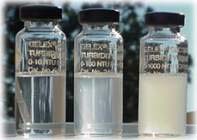Formazine
Formazine (formazin) is a

The hexamethylenetetramine tetrahedral cage-like structure, similar to adamantane, serves as molecular building block to form a tridimensional polymeric network.
Formazine is very poorly soluble in water and when directly synthesized in aqueous solution, by simply mixing its two highly soluble precursors, it forms small size
In the
Turbidity measurement
For turbidity measurement, a formazine suspension is prepared by mixing solutions of 10 g/L hydrazine sulfate and 100 g/L hexamethylenetetramine with
The purity of the water used in the preparation of the formazine dispersion is also important as it cannot initially contain colloidal particles. Experience shows that water filtered as required has a residual scatter of about 0.02 FTU = 20 mFTU (inherent brightening effect). This has to be taken into account during
See also
References
- ^ Kingsbury F. B., Clark C. P., Williams C., and Post A. L. (1926). "The rapid determination of albumin in urine". J. Lab. Clin. Med. 11 (10): 981–989. Archived from the original on 2022-02-24. Retrieved 2022-02-24.
{{cite journal}}: CS1 maint: multiple names: authors list (link) - .
- ISBN 978-0-08-087512-5. Archivedfrom the original on 8 July 2014. Retrieved 5 May 2013.
- ISBN 978-1-84339-277-4. Retrieved 5 May 2013.
- ^ "British Pharmacopoeia". Archived from the original on 2022-02-24. Retrieved 2022-02-24.
